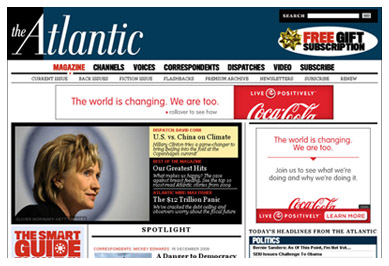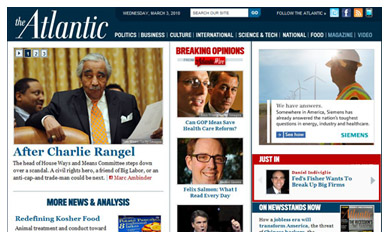At 1 a.m. last Friday, TheAtlantic.com rolled out a much-anticipated new redesign. By 4 p.m. Monday, the redesign had already undergone a redesign.
Web site redesigns always provoke a bit of howling from loyal visitors who are used to the old layout (See: every time Facebook has ever changed its homepage). But the pushback against The Atlantic’s redesign was particularly furious—in part because it was driven by the magazine’s own bloggers.
The new homepage emphasizes topic-centric “channels” such as Politics, Culture, and Science & Technology splashed across the top of the page. Each individual blog post written by TheAtlantic.com’s marquee names—Andrew Sullivan, Megan McArdle, Ta-Nehesi Coates, Marc Ambinder, James Fallows, Jeffrey Goldberg, and others—is now cross-posted to the appropriate “channel.”

The old homepage

The new homepage
According to TheAtlantic.com editorial director Bob Cohn, the idea was to make it easier for readers to find content by topic of interest, to create some serendipity and make it easier for new users unfamiliar with The Atlantic’s all-star roster of bloggers to bump into their work, and to get dedicated followers of those bloggers to branch out at the same time. “We had the sense we were creating a lot of good content that users weren’t finding,” said Cohn.
As Ezra Klein and others noted, this new orientation serves to emphasize Atlantic content in general rather than any individual Atlantic blogger. But the real problem wasn’t the new channels or even the cross-posting. It was that the bloggers’ individual pages had changed—and not for the better.
No longer could readers scroll through any given blogger’s page and read his or her latest posts in full. Instead, those pages had been transformed into little more than lists of recent headlines; readers had to click on each individual headline in order to read the entry. It seemed as if the individual bloggers had been subsumed by the channels. As one commenter put it:
I like what [Ta-Nehisi Coates] does enough that I’ll probably give this a shot. But I’m disgusted with The Atlantic for taking away his blog, and leaving him with nothing more than what you get when – for example – you click the name of a journalist on a newspaper’s website. It’s just a list of his recent offerings, with single-sentence links. That’s not a blog. It’s an archive search function. It’s online journalism with tagging.
This made some of those marquee personalities less than happy, and they weren’t shy about saying so. On his Daily Dish blog, Sullivan wrote that the redesign of the bloggers’ homepages was a fundamentally ignorant move:
Treating blogs as a series of headlines, designed to maximize pageviews, is a deep misunderstanding of blogs, their reader communities and their integrity. I hope they get restored to their previous coherence, and these amorphous “channels” gain some editorial identity. I hope writers like Fallows and Goldberg aren’t treated as random fodder – anchors! – for “channels”. I believe in the Atlantic as a place for writing. The redesign seems to me to ooze casual indifference to that and to the respect that individual writers deserve.
Fallows was similarly perturbed:
It is no secret within our organization that I think the new design creates problems for the magazine’s “personal” sites, like the one I have been running here these past few years. In particular, the new layout scheme — in which you see only a few-line intro to each post but no pictures, block quotes, or other amplifying material — unavoidably changes the sensibility and tone of personal blogs. It drains them of variety and individuality, not to mention making them much less convenient to read.
The uproar took The Atlantic’s Web team by surprise, and they soon realized they had made a mistake in changing the format of the bloggers’ homepages. According to Cohn, it wasn’t a difficult decision to change things back. “This was purely a miscalculation about what would be the smoothest way for people to navigate the site,” he said. “To see it live is just different than to see it flat. And when it went live, with the help of the community, we realized this was an inferior way to navigate our bloggers.”
They quickly set to restoring the original look of each writer’s homepage. It took less than one full business day to make the changes. “Web Site Paradise Restored!” James Fallows proclaimed after the re-redesign was launched yesterday.
Still, the fix of the bloggers’ individual sites does not change the fact that The Atlantic has introduced a new way to think about Atlantic online content. As Klein wrote before the changes were made yesterday, the redesign isn’t necessarily bad—it’s just a different animal. TheAtlantic.com writers have always been brands unto themselves, but the new clearly labeled “channels” now promote the Atlantic brand over the individual personalities that write for it online:
As things stood a week ago, there really was no Atlantic online. Instead, there was a respected magazine called The Atlantic Monthly that had agreed to offer web hosting to a certain number of blogs. You never heard anyone say “did you read the Atlantic online today?” Instead, it was whether you’d read Ta-Nehisi, or Andrew, or Fallows. The magazine designated them “voices,” but the redesign suggests that it eventually realized they were the only ones being heard. . . I see the appeal of making sure that the blogs are part of the greater glory of the Atlantic, as opposed to the greater glory of the bloggers.
But Cohn disagreed that the bloggers were being de-emphasized in relation to the Atlantic brand as a whole. “The bloggers are the absolute centerpiece of the Web site,” he said, pointing out that the homepage now features the names and photographs of the site’s key bloggers, alongside links to their latest posts. “The success of TheAtlantic.com is our bloggers, and we’d be crazy to mess with that.”
In other words, Cohn wasn’t about to let his bloggers stay unhappy for long. By the end of the day yesterday, most of the site’s bloggers had come down in favor of the redesign and the “channel” format. As Megan McArdle wrote even before the changes were made:
The Internet is great precisely because it enables rapid experimentation, and failure, and change of the things that don’t work. But there’s no way of knowing whether something will work until you’ve tried it.
And after spending a weekend with his team working overtime on the redesign fix, Cohn agreed.
“It’s incredible that you can work so long on something, realize you made a mistake and fix it within forty-eight hours. It’s incredible.”
Alexandra Fenwick is an assistant editor at CJR.
